Discover 20 hidden attractions, cool sights, and unusual things to do in Erfurt (Germany). Don't miss out on these must-see attractions: Erfurt Cathedral, Angermuseum, and Memorial and Education Centre Andreasstraße. Also, be sure to include Augustinerkloster in your itinerary.
Below, you can find the list of the most amazing places you should visit in Erfurt (Thuringia).
Table of Contents
Erfurt Cathedral

Also known as: Erfurter Dom
Romanesque and Gothic style city icon. Erfurt Cathedral, also known as St Mary's Cathedral, is the largest and oldest church building in the Thuringian city of Erfurt, central Germany. It is the episcopal seat of the Roman Catholic Diocese of Erfurt. The cathedral was mainly built in the International Gothic style and is located on a hillside overlooking the main town square. Former German names include Marienkirche and Propsteikirche Beatae Mariae Virginis.[1]
Address: Domstufen 1, 99084 Erfurt
Angermuseum

Museum in Erfurt, Germany. The Angermuseum is an art museum in Erfurt opened on 27 June 1886.[2]
Address: Anger 18, 99084 Erfurt
Memorial and Education Centre Andreasstraße

The Memorial and Education Centre Andreasstraße, is a museum in Erfurt, Germany, which is housed in a former prison used by the East German Ministry for State Security. It is informally known as the Stasi Museum.
From 1952 until 1989, over 5000 political prisoners were held on remand and interrogated in the Andreasstraße prison, which was one of 17 Stasi remand prisons in the German Democratic Republic (East Germany). The museum was opened in 2013 as a memorial to repression and resistance in the Thuringia region during the GDR dictatorship. Its permanent exhibitions focus on the experiences of the prison's inmates, the activities of the Stasi, life under the dictatorship, and the Peaceful Revolution which led to German reunification.
On 4 December 1989, local citizens occupied the prison and the neighbouring Stasi district headquarters to stop the mass destruction of Stasi files. It was the first of many occupations of Stasi premises throughout the country, and it was a milestone in the Peaceful Revolution. It led to the preservation and opening of Stasi files so that citizens could see what information was held on them and so that the crimes of the Stasi could be exposed.
The prison was opened in 1878 and held political prisoners for several different political regimes until 1989. It was closed in 2002.
The Memorial and Education Centre Andreasstrasse is managed by the Stiftung Ettersberg.[3]
Address: 37a Andreasstraße, Erfurt
Augustinerkloster
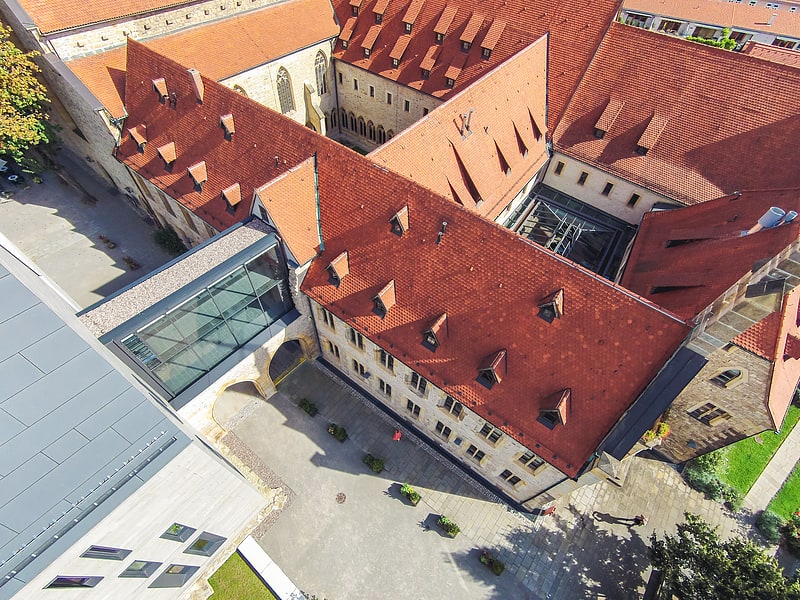
Monastery in Erfurt, Germany. St. Augustine's Monastery in Erfurt, central Germany, is a former church and monastery complex dating from the 13th century. The site is almost one hectare in size. It was built by Augustinian friars, an order of the Catholic Church. It is most well known as the former home of Martin Luther, the father of the Reformation, who lived there as a friar from 1505 until 1511.
About 74 ordained and 70 lay brothers lived at the monastery at its peak in the early 16th century. After the Reformation, from 1525 the monastery church was used by the local Lutheran congregation. The site became the property of Erfurt city council after the last friar died in 1556. It was secularised in 1559, but was later reconsecrated in 1854. It now belongs to the Evangelical Church in Central Germany.
Parts of the complex were destroyed in a British air raid in 1945, in which 267 people sheltering on the site were killed. Today the complex has a mixture of medieval and modern buildings. It is now used as a place of worship and as a meeting and conference centre. Music concerts are performed in the church, which has a Walcker organ, built in 1938. It also provides simple accommodation for travellers and for retreats.
In February 2016, an application was made to have St. Augustine's Monastery, along with 11 other sites, added to the UNESCO World Heritage Site designated "Luther Sites in Central Germany". Because of their role in the Reformation, all of these sites are considered to "represent one of the most important events in the religious and political history of the world".[4]
Address: Augustinerstr. 10, 99084 Erfurt
Old Synagogue
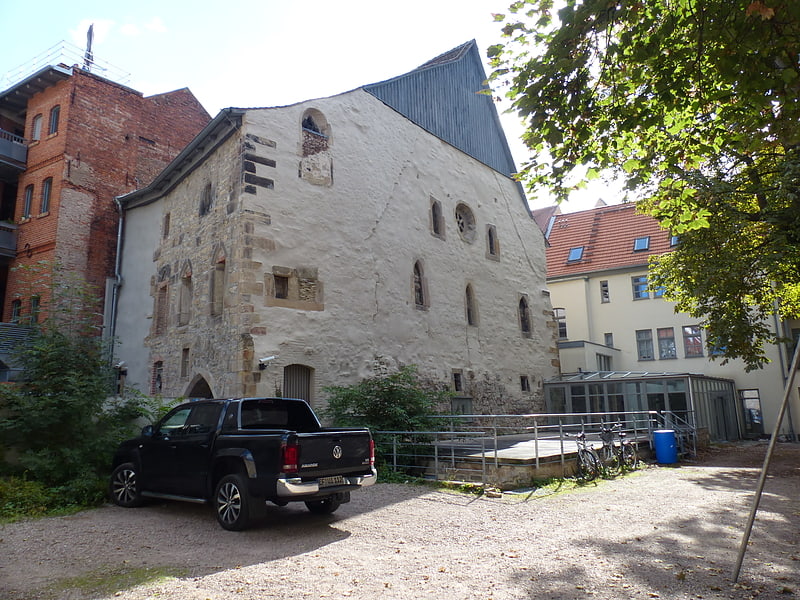
Also known as: Alte Synagoge
Synagogue in Erfurt, Germany. The Alte Synagoge in Erfurt, Germany, is one of the best preserved medieval synagogues in Europe, its oldest parts dating back to the late 11th century. Most parts of the building date from around 1250–1320. It is thought to be the oldest synagogue building intact to its roof still standing in Europe.
Since 2009 it has been used as a museum of local Jewish history. It houses the Erfurt Treasure, a hoard of medieval coins, goldsmiths' work and jewellery found in 1998. It also has facsimiles of the Erfurt Hebrew Manuscripts, an important collection of 12th-14th century religious texts that belonged to the medieval Jewish community of Erfurt.
The Historic Synagogues of Europe project, carried out by the Center for Jewish Art at the Hebrew University of Jerusalem, has given the Old Synagogue, Erfurt its highest level of significance rating: 4 (International) – "The building is of outstanding architectural, urban or historical importance. It has unique features and/or is especially influential internationally as an architectural pattern."
In 2015 it was proposed as a UNESCO World Heritage Site.[5]
Address: Waagegasse 8, 99084 Erfurt
Topf and Sons
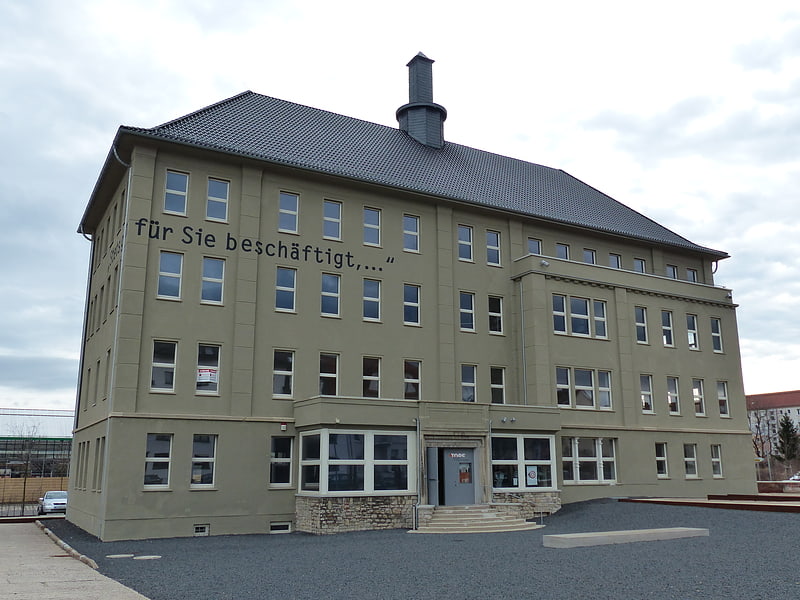
Also known as: J. A. Topf & Söhne
J.A. Topf and Sons was an engineering company, founded in 1878 in Erfurt, Germany by Johannes Andreas Topf. Originally, it made heating systems and brewing and malting equipment. Later, the company diversified into silos, chimneys, incinerators for burning municipal waste, and crematoria. During World War I it made weapons shells, limbers and other military vehicles. In World War II it also made weapons shells and aircraft parts for the Luftwaffe.
It is now infamous as the largest of 12 companies that designed and built crematoria ovens for concentration and extermination camps during the Holocaust, planned and carried out by the Nazi regime from 1935 to 1945. The company not only made crematoria ovens, it also made ventilation systems for the gas chambers at Auschwitz II–Birkenau.
Topf & Söhne's main competitor in making concentration camp ovens was the Berlin firm H. Kori GmbH, founded in 1887.
At its peak Topf & Söhne was the largest company of its type in the world. It sold its products globally; as far afield as Russia, Asia, North and South America, Australia, and New Zealand. In the 1940s, less than 2% of its total business came from its concentration camp contracts.
In addition to Auschwitz and Auschwitz II–Birkenau, Topf & Söhne also built crematoria ovens for Buchenwald, Dachau, Mauthausen-Gusen, Mogilev ghetto, and the Gross-Rosen concentration camp. Out of the five ovens at Dachau concentration camp, four were made by H. Kori and one by Topf & Söhne. In all, Topf built 25 crematoria ovens which had a total of 76 incineration chambers (called 'muffles') for concentration camps. H. Kori built 42 single chamber ovens at various camps.
Epithets such as 'the engineers of the final solution' and 'the technicians of mass murder' have been applied to Töpf & Söhne, because, to a greater extent than its competitors, it used its considerable expertise to assist the Nazi regime to make mass execution into an efficient, industrial process.
From 1941, Topf & Söhne used forced labour in its factory, as did many other German firms in the Nazi period. At least 620 foreigners were forced to work for the company. These people received wages, but they were paid 25–30% less than the German employees. After the war, the company was confiscated and nationalised by the Soviet administration. The company's history was not fully researched until after German reunification in 1990.
The site of the former factory is now a Holocaust memorial site and a museum. It is the only memorial of its type relating to a civilian company's collaboration in the Holocaust.[6]
Address: Sorbenweg 7, 99099 Erfurt
Krämerbrücke
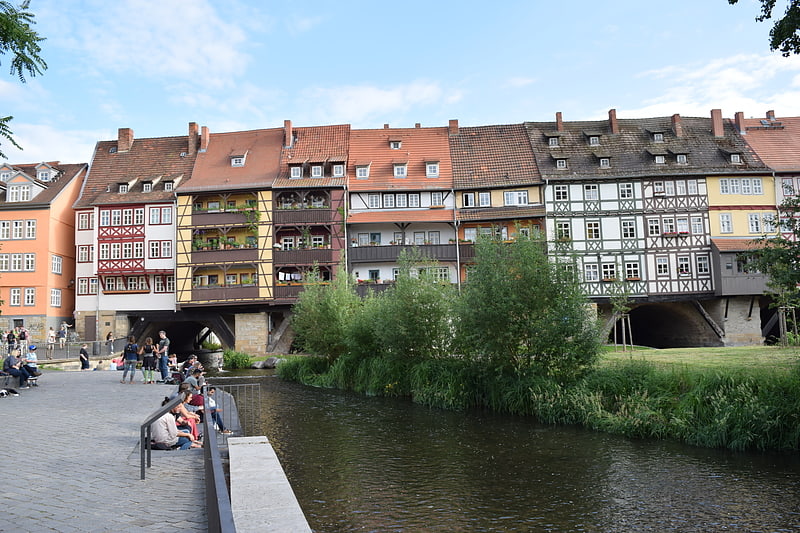
Ancient bridge with homes and stores. The Krämerbrücke is a medieval arch bridge in the city of Erfurt, in Thuringia, central Germany, which is lined with half-timbered shops and houses on both sides of a cobblestone street. It is one of the few remaining bridges in the world that have inhabited buildings. It has been continuously inhabited for over 500 years, longer than any other bridge in Europe. The stone, pedestrian bridge, which dates from 1325, is one of the oldest secular structures in Erfurt. It spans the Breitstrom, a branch of Gera River, and connects two town squares – Benediktsplatz and Wenigemarkt.[7]
Erfurt Charterhouse
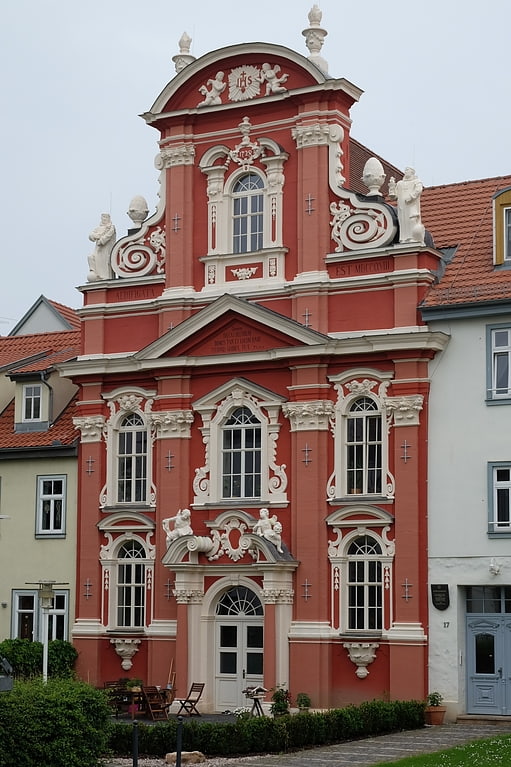
Monastery. Erfurt Charterhouse is a former charterhouse, or Carthusian monastery, in Erfurt, Thuringia, Germany. It was founded in the 1370s: building works began in 1372 and the monastery was accepted into the Carthusian Order in 1374. Work started on the church in 1375.
The monastery quickly attracted rich endowments and prospered so much that it was able to launch the foundations of two new charterhouses, Eisenach Charterhouse in 1383 and Hildesheim Charterhouse in 1387.
The charterhouse survived the Reformation but was much reduced. It was looted in the Peasants' War, the Thirty Years' War and finally at secularisation in 1803, and nothing survived of its once-substantial treasury. Its library however passed to the University of Erfurt.
The original Gothic buildings (cloisters, cells, chapter room and chapel) were much augmented by Baroque construction in the 18th century.
The premises were mostly destroyed by fire in 1845. The church survives but was radically converted to residential use in 2012.[8]
Steigerwaldstadion
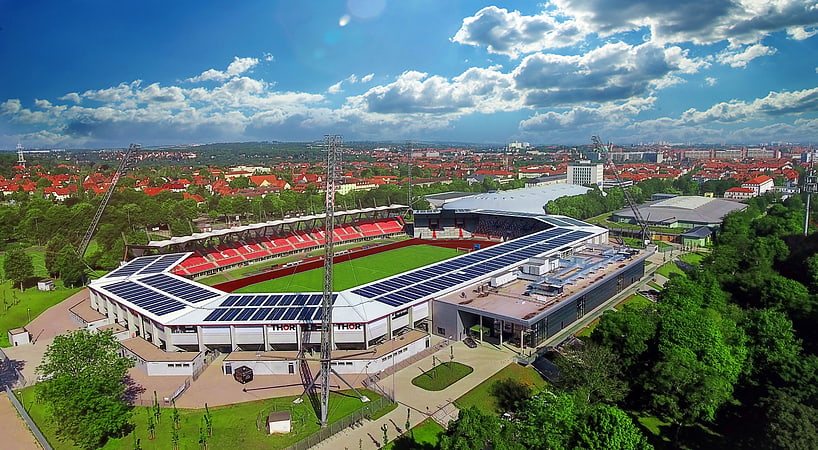
Multi-purpose stadium in Erfurt, Germany. Steigerwaldstadion is a multi-purpose stadium in Erfurt, Germany. The stadium is able to hold 18,611 people and was built in 1931. It is currently used mostly for football matches and is the home stadium of FC Rot-Weiß Erfurt.
From 1948 to 1991 (the time of the German Democratic Republic), Steigerwaldstadion was known as the Georgij-Dimitroff-Stadion, after Bulgarian communist leader Georgi Dimitrov (1882–1949).
Bon Jovi performed at the stadium during their These Days Tour on June 13, 1996 & during their Bounce Tour on May 25, 2003.[9]
Address: Arnstädter Str. 55, 99096 Erfurt
Predigerkirche

Evangelical church in Erfurt, Germany. Predigerkirche is a Protestant church in Erfurt, Germany. It is a monastic church to the Dominican friary, Predigerkloster, adjacent to the church. Predigerkirche was originally built by the Dominican Order in the 13th century, when the mystic Meister Eckhart was prior here. The original building was modified in 1340–50, and the bell tower was built between 1447 and 1488. The church only became a Protestant church after the Reformation. Around 1806 Predigerkirche was used as a Prisoner of war camp, which led to damage to the interior and the equipment. Repairs were made around 1826.[10]
Address: Predigerstr. 5, 99084 Erfurt
Zitadelle Petersberg
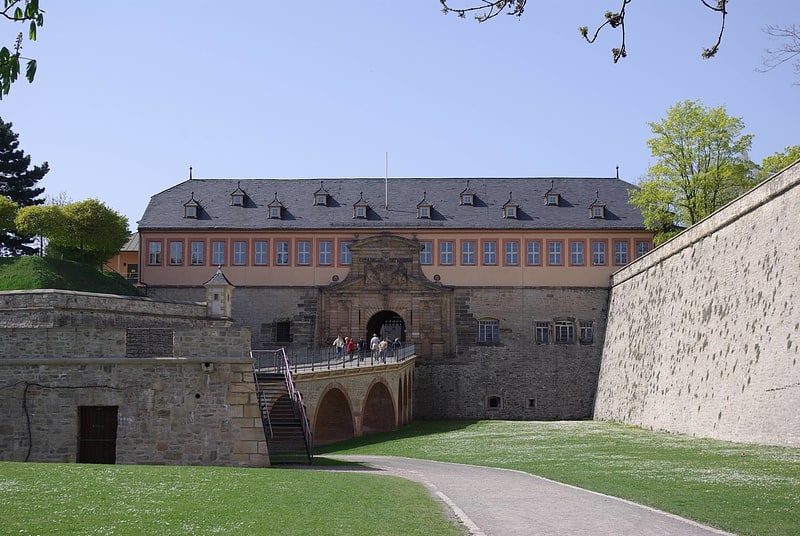
Historical landmark in Erfurt, Germany. Petersberg Citadel in Erfurt, central Germany, is one of the largest and best-preserved town fortresses in Europe. The citadel was built on Petersberg hill, in the north-western part of the old town centre from 1665, when Erfurt was governed by the Electorate of Mainz. It is surrounded by over two kilometres of stone walls and is 36 hectares in size.
Erfurt has also been ruled by Sweden, Prussia, Napoleon, the German Empire, the Nazis, and post-World War II Soviet occupying forces, and it was part of the German Democratic Republic (East Germany). All of these regimes used Petersberg Citadel and had an influence on its development. The baroque fortress was in military use until 1963. Since German reunification in 1990, the citadel has undergone significant restoration and it is now open to the public as a historic site. Its maze of underground passageways are also open to visitors and the fortress bakery (1832) is again in working order.
The fortress is also known by its French name, Citadelle Petersberg, as French troops were stationed there from 1806 to 1814, when Erfurt was under Napoleonic occupation. Napoleon visited Erfurt several times and the citadel was further developed during his rule, although parts of it were damaged in a battle in 1813.
The citadel was built on the site of a medieval Benedictine Monastery and the earliest parts of the complex date from the 12th century.
The former lower barracks (German:Untere Kaserne) building is now used to house and administer archives of the Stasi Records Agency.
The Cyriaksburg Citadel, is a smaller fortress to the south-west of Erfurt city centre, which dates from 1480. It is now the home of the German Horticulture Museum. During the Napoleonic period a hidden trench connecting the two citadels was built. The remains of this connection can still be seen at the Cyriaksburg Citadel today.[11]
Maria Gloriosa
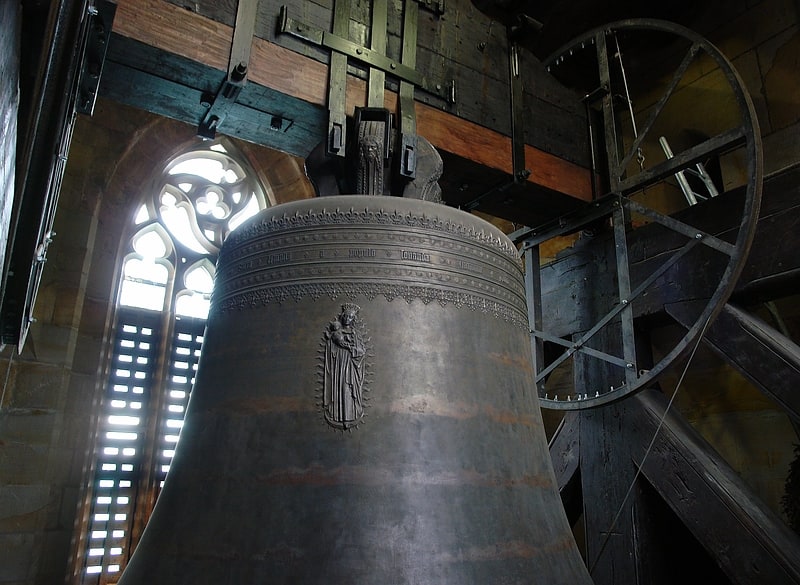
Also known as: Gloriosa
Maria Gloriosa, or the Erfurt Bell, is a well-known bell of Erfurt Cathedral, cast by Geert van Wou in 1497. The world's largest medieval free-swinging bell, it is now swung electrically. It was welded in 1985 to repair a crack, then, in August 2004, the bell was re-fused due to another crack from 2001.
Diameter: 8 feet 5+3⁄4 inches, weight: 13 tons 15 cwts. note: E. Alternately: 2570mm, 11450 kg, note by today's standards: F-. It is about 2 meters tall.
As with any well-tuned bell the hum tone is near an octave below the strike tone, and all other notes are in tune including the minor third, fifth, octave, and major third and fifth in the second octave that may be heard in large bells.[12]
Address: Fischersand 9, 99084 Erfurt
Theater Erfurt
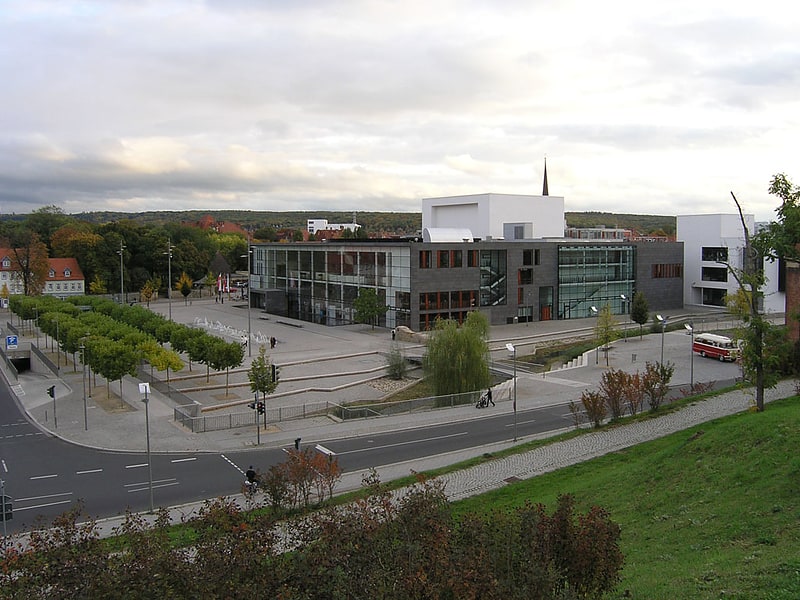
Theatre in Erfurt, Germany. The Theater Erfurt is a German municipal theatre located in Erfurt, the capital of Thuringia. The main stage is in a building in the Brühlervorstadt, completed in 2003. The theatre offers musical theatre and concerts, played by the Philharmonisches Orchester Erfurt. Ballet and plays are offered by guest performances. The company organizes the annual open air festival DomStufen. The theatre's current Generalintendant, Guy Montavon, has held the post since 2002.[13]
Address: Theaterplatz 1, 99084 Erfurt
Natural History Museum

Also known as: Naturkundemuseum
Museum in Erfurt, Germany. The Natural History Museum of Erfurt is a natural history museum in Erfurt, Germany.
The museum has a permanent exhibition relating the natural history of the forests, fields, city and the geological history of Thuringia. There is also a special exhibitions programme. The museum has collections of botany, zoology, mineralogy — 6,500 specimens presented by Godehard Schwethelm (1899–1992) — and palaeontology. The statutory goals of the museum are the promotion of scientific research and education, the care of scientific collections and hosting scientific meetings.[14]
Address: Große Arche 14, 99084 Erfurt
Egapark
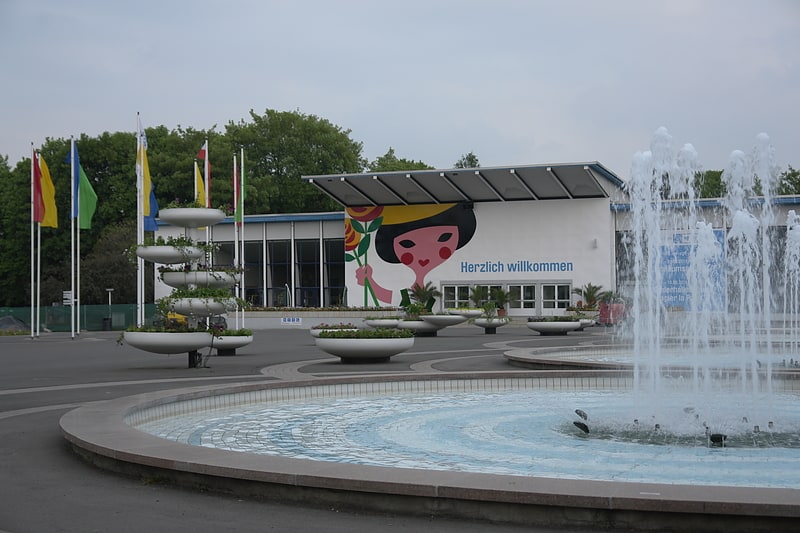
With an area of 36 hectares, egapark in Erfurt is one of Germany's large garden and leisure parks. The park area is located in the southwest of the city on the 265 meter high Cyriaksberg. Originating from a former city fortification, the area was redesigned as a public green space from 1885 and subsequently further developed. After a first horticultural show in 1950, the International Horticultural Exhibition, held regularly from 1961 onwards, was the largest and most important event of its kind in the GDR and in the socialist camp.
The facility, which is open year-round and requires an entrance fee, combines various exhibition halls, plant show houses, themed gardens and rest areas. The main attractions in the egapark include, in addition to the largest contiguous flower bed in Europe with 6000 square meters, an observation tower, an observatory as well as the largest children's playground in Thuringia and the only horticultural museum in the country.
The park, which has been a listed monument since 1992 due to its unique horticultural design concept, is one of the main works of the landscape architect Reinhold Lingner and is one of the most important testimonies to the garden architecture of the 1960s in Germany. Representing the long horticultural tradition of the "flower city" of Erfurt, the garden show grounds have been visited by over 45 million guests since 1961. With an average of 450,000 visitors per year, egapark is - next to Wartburg Castle - the most visited tourist attraction in Thuringia.
Address: Gothaer Str. 38, 99094 Erfurt
Domplatz Erfurt
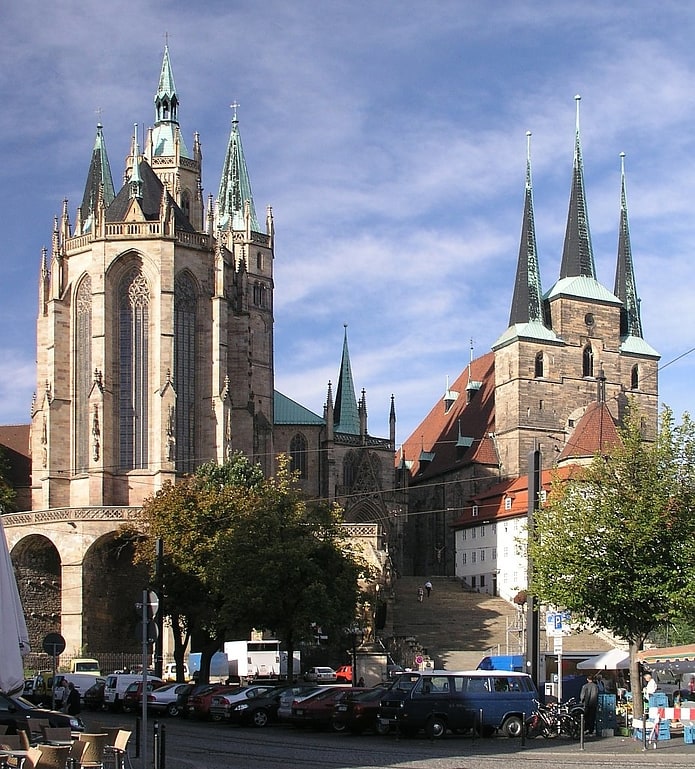
The cathedral square in Erfurt is a large market square of about 3.5 ha, with intact or restored perimeter buildings. It was once the main market place and court square. The square is home to the Minerva Fountain and the Erthal Obelisk, erected in 1777 in honor of the Elector of Mainz.
Mittelalterliche Mikwe
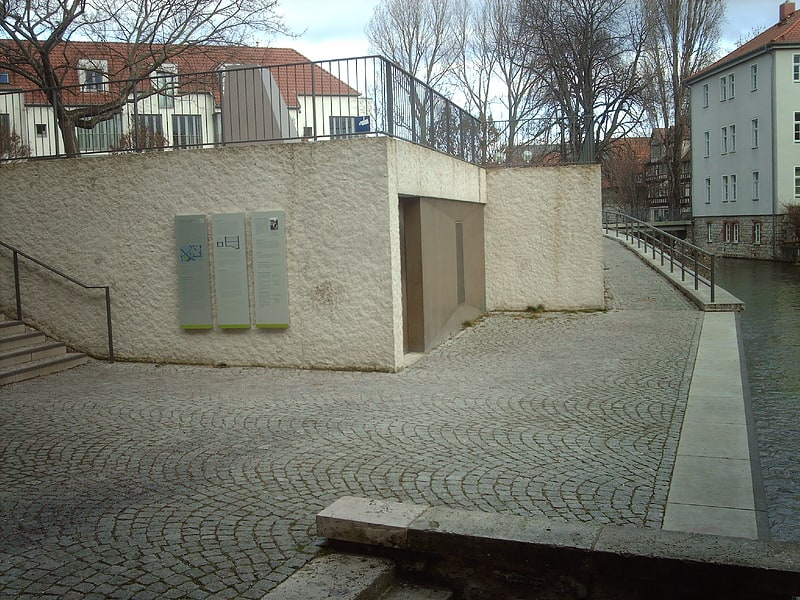
The Erfurt Mikvah is a Jewish ritual bath of medieval origin in the old town of Erfurt on the river Gera in the area of the Krämerbrücke. It belongs to the Erfurt Network Jewish Life.
The mikvah was rediscovered in 2007 and was opened to the public as a cultural site in 2011. The location of the facility was therefore favorable, as the necessary groundwater was already available at a shallow depth directly on the Gera River. A predecessor building of the ritual bath can be dated to the 12th century. The existing mikvah dates back to the 13th century. It was first mentioned in 1248 and used until the expulsion of the Jews in 1453. After that, the water basin was filled in and the room was used as a cellar. In the town fire of 1472, the building was damaged and subsequently repaired and reduced in size by half. It stood in a row with two other half-timbered houses directly on the river bank. During the Second World War, the narrow development of the quarter was considered a source of danger in the event of bombing, and the building with the mikvah and the neighboring house were therefore demolished. The remaining buildings were demolished at the latest when the green area was created in the run-up to the IGA in the 1960s. The reason for the renewal and reshaping of this green space was the collapse of a fortification wall. The mikvah was rediscovered during the archaeological investigations accompanying the construction work.
The mikvah was submitted to UNESCO in 2021 together with the Old Synagogue and the Stone House as Jewish-Medieval Heritage Erfurt.
Hirschgarten (Erfurt)
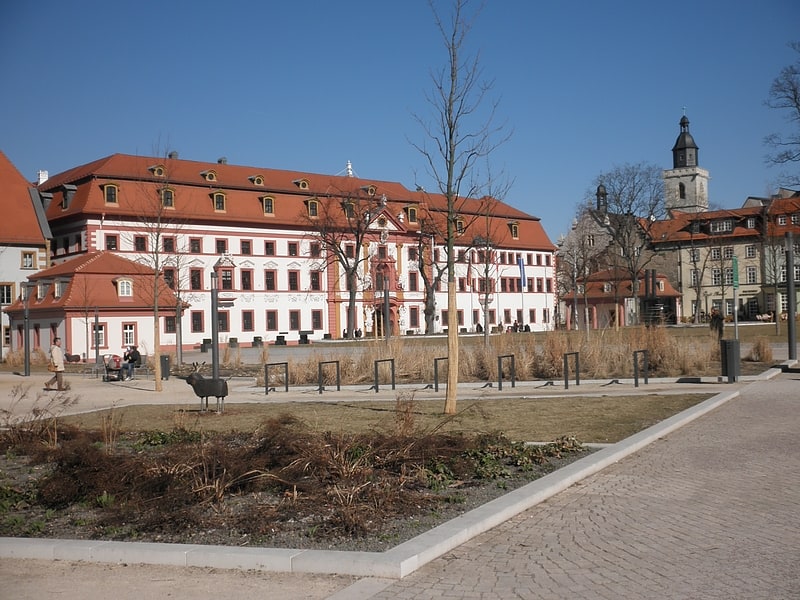
The Hirschgarten is a partially park-like green space in the old town of Erfurt. It was the first public green space in the city. It is now a "park duo" consisting of the historic 18th-century Hirschgarten and a section adjoining it to the west, which was landscaped on demolition land between 2007 and 2009.
Ägidienkirche
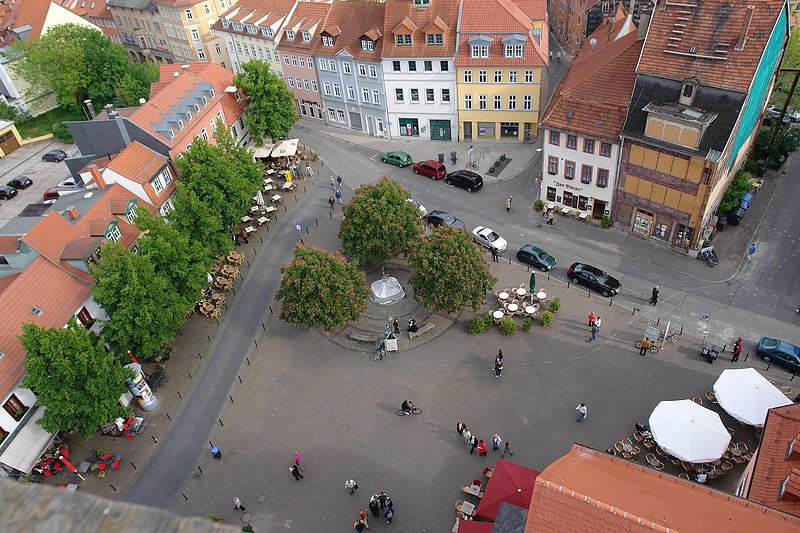
The Ägidienkirche in Erfurt forms the eastern entrance to the Krämerbrücke at the Wenigemarkt with its archway. It is one of the former two bridgehead churches. At the western end stood the Benediktikirche since the 11th century, which was demolished in 1890 and is remembered today only by the name of Benediktsplatz.
Address: Wenigemarkt 4, 99084 Erfurt
Maislabyrinth Erfurt
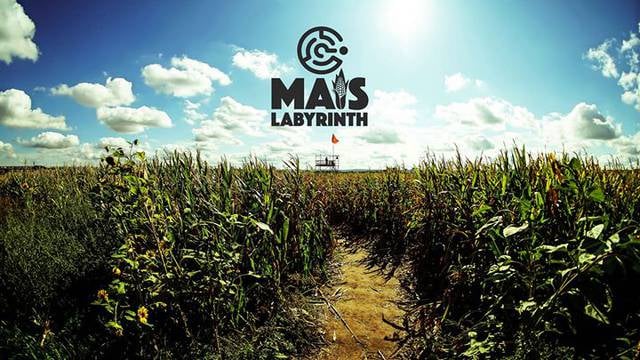
Amusement, Game and entertainment center, Park, Amusement park
Address: Demminer Str. 30, 99091 Erfurt